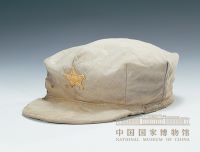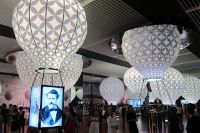What I did this morning really summarized at least the China part of the month-long journey. I got up in the morning and stood in line (for an hour) waiting for the National Museum to open. The tickets are free, but limited, so getting there early was a priority. I think I was number 20 in line. I had time to see three exhibits (not necessarily in this order):
The first one was Ancient China to 1911. While I took some pictures of the artifacts, I was more fascinated by the explanations of the dynasties and what they brought to Chinese history. The coverage included descriptions of the Chinese periphery (the other than Han peoples) and some information on foreign relations. I paid special attention to the 80-year Yuan Dynasty (founded by Genghis Khan). Most museums have wondrous collections of Chinese materials; Scouts who went to New Hampshire last year with me  saw one in the Royal Ontario Museum in Toronto. What was surprising to me was that the last time I was here (the museum seemed to be always closed), which was probably around 2000, the exhibits stopped at the Ming Dynasty, and the explanations could have been lifted directly from Marx, Engels, Lenin, and Mao—and probably were. Feudal was the most common word (or to put it one way, it was like the museums in Vietnam). I remember asking my colleague Dr. Jin why history stopped around 1400. Based on his experience as a mainlander whose family was persecuted during the Cultural Revolution, he suggested that any closer to the present incurred the risk of a revision in the party line—and dire consequences for the historian. 1400 was safe.
saw one in the Royal Ontario Museum in Toronto. What was surprising to me was that the last time I was here (the museum seemed to be always closed), which was probably around 2000, the exhibits stopped at the Ming Dynasty, and the explanations could have been lifted directly from Marx, Engels, Lenin, and Mao—and probably were. Feudal was the most common word (or to put it one way, it was like the museums in Vietnam). I remember asking my colleague Dr. Jin why history stopped around 1400. Based on his experience as a mainlander whose family was persecuted during the Cultural Revolution, he suggested that any closer to the present incurred the risk of a revision in the party line—and dire consequences for the historian. 1400 was safe.
The new exhibit, much more spritely displayed, demonstrated why China’s cultural supremacy was so pronounced in Vietnam and East Asia.


The second exhibit I found quite by mistake. It had some weird title like,
“the Rejuvenation of the Chinese People.” It was also in a difficult-to-get-to part of the immense building, which is a twin to the Great Hall of the People, where 1000 delegates meet in the Chinese Parliament. I suspected it was the party view of history since 1840, since I knew that the new Museum had merged with the Museum of the Revolution. When I got into the exhibit, I realized that yes, it was about the freeing of the Chinese people from the century of humiliation, and I was the only foreigner there. The captions were mostly in Chinese, but it’s the Chinese I could read (sort of) from learning my Chinese during the Cultural Revolution. There was the otherwise missing rhetoric on feudal society and the imperialists who made war on China and whose businessmen and missionaries drove a militarist policy that reduced China to poverty and oppression. This was the “remember history, save the nation” that I saw in several places, culminating with a party history of the period through the end of the 1990s and the wisdom of following Deng Xiaoping’s version of Communism—the creation of the New China.
The third exhibit was the one I knew I had to see more than I wanted to see.  It was the “New New China,” the global player of global economic integration (and political influence), as emphasized by Louis Vuitton and some of the art he inspired. The first room was dominated by octagonal mirrors featuring a video of an explosion of a rock, called “the beginning.” One of the highlights was a variety of trunks that LV had created over the near-century of its existence. This was the “New New China” I’ve been talking about (and if there’d been a few copy-LV bags, it would have been perfect).
It was the “New New China,” the global player of global economic integration (and political influence), as emphasized by Louis Vuitton and some of the art he inspired. The first room was dominated by octagonal mirrors featuring a video of an explosion of a rock, called “the beginning.” One of the highlights was a variety of trunks that LV had created over the near-century of its existence. This was the “New New China” I’ve been talking about (and if there’d been a few copy-LV bags, it would have been perfect).
And then it was time to go home. Here’s what I’ll miss (and some of the items on it may surprise you).
1) Fresh pineapple in Thailand, and fresh fruit in Southeast Asia
2) Murtabak in Malaysia, and the ambience of Penang
3) Order in Singapore, but the chance to bicycle in a jungle
4) Crossing the street or walking on the sidewalks in Vietnam. Good exercise. Adrenaline rises.
5) Vietnamese food
6) Vietnamese prices
7) Old and new friends in all of Asia
8 ) Hong Kong scenery
9) Macau’s resemblance to Lisbon, and vice versa
10) Imperial sights in Beijing
11) Traveling with students, sharing experience and enthusiasm and knowledge. Hopefully, some will be infected.
12) Traveling alone, which I enjoy partly because of #11. Better restaurants as a result, and am responsible for one irresponsible person.
13) Crowds, because there must be something worthwhile at the end
14) Solitude, because crowds make you appreciate it when you can get it
15) Realizing nothing’s in English and no one speaks English and it’s obvious I’m from out of town
16) Learning new things, and remembering old. Putting things together to make sense.
17) Learning from guides. And sometimes teaching them.
18) Asian toilets. I like a challenge.
19) Long train rides. Did you ever find where I left those cobras on the train in Vietnam?
20) Beijing duck someplace atmospheric
21) Working on my Chinese to the point where Chinese answer back in Chinese—and I understand what they’re saying
22) Long flights are great if you can sleep—or if you read
23) Mindlessly wandering through markets or parks
24) Asia
25) Adventure. Give me a few days and I’ll be ready for my next one!